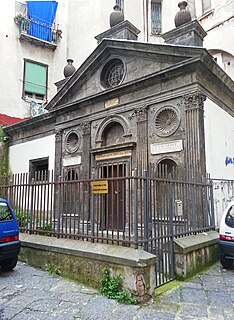
Francesco Scipione Maffei was a Venetian writer and art critic, author of many articles and plays. An antiquarian with a humanist education whose publications on Etruscan antiquities stand as incunables of Etruscology, he engaged in running skirmishes in print with his rival in the field of antiquities, Antonio Francesco Gori.

I quattro libri dell'architettura is a treatise on architecture by the architect Andrea Palladio (1508–1580), written in Italian. It was first published in four volumes in 1570 in Venice, illustrated with woodcuts after the author's own drawings. It has been reprinted and translated many times, often in single-volume format.

Michele Sanmicheli (1484–1559), was a Venetian architect and urban planner of Mannerist-style, among the greatest of his era. A tireless worker, he was in charge of designing buildings and religious buildings of great value.
Domenico de' Rossi (1659–1730) was an Italian sculptor and engraver.
Bevilacqua is a comune with 1,927 inhabitants in the province of Verona, Italy.

Domenico Antonio Vaccaro was an Italian painter, sculptor and architect. He created many important sculptural and architectural projects in Naples. His later works are executed in an individualistic Rococo style.

Bernardo Antonio Vittone was an Italian architect and writer. He was one of the three most important Baroque architects active in the Piedmont region of Northern Italy; the other two were Filippo Juvarra and Guarino Guarini. The youngest of the three, Vittone was the only one who was born in Piedmont. He achieved a synthesis of the spatial inventiveness of Juvarra and the engineering ingenuity of Guarini, particularly in the design of his churches, the buildings for which he is best known.
Massimo Carmassi is an Italian architect.

Palazzo Dalla Torre is a patrician palace in Verona, northern Italy, designed by Italian Renaissance architect Andrea Palladio for Giambattista Dalla Torre. The palazzo was probably built from 1555, but remained unfinished. Allied bombardment in 1945 demolished a great part of the building. However, conspicuous remains of Palladio’s construction survive: the majestic access portal and a courtyard with columns and entablature.

Giovanni Francesco Mormando was an Italian architect active in Naples, Italy.

Giovanni Antonio Antolini was an Italian architect and writer.
Carlo Murena was an Italian architect of the late-Baroque period active in Rome, Foligno, Perugia, and other towns in central Italy. He was a pupil of Niccolo Salvi, but was sent to train with Luigi Vanvitelli, who was then building the Lazzaretto of Ancona.
Paolo Brescia is an Italian architect and founder of OBR Open Building Research. He graduated with a degree in architecture from the Politecnico di Milano in 1996 and had his academic fellowship at Architectural Association in London. After working with Renzo Piano, he founded in 2000 OBR with Tommaso Principi to investigate new ways of contemporary living, creating a design network among Milan, London, Mumbai and New York. He combines his professional experience with the academic world as guest lecturer in several athenaeums, such as Accademia di Architettura di Mendrisio, Kent State University, Aalto University, University of Oulu, Academy of Architecture of Mumbai, College of Architecture of Pune, Mimar Sinan Fine Art University, Hacettepe University, Florida International University in Miami. He was university professor in charge at Politecnico di Milano (2004-2005) and University of Genoa (2013-2015). With OBR his projects have been featured in international exhibitions, including at X Biennale di Architettura in Venice 2006; RIBA Royal Institute of British Architects in London 2007; V Bienal de Arquitetura in Brasilia 2007; XI Bienal Internacional de Arquitectura in Buenos Aires 2007; AR Award Exhibition in Berlin 2008; China International Architectural Expo in Beijing 2009; International Expo in Shangai 2010; UIA 24th World Congress of Architecture in Tokyo 2011; Energy at MAXXI in Rome 2013; Italy Now in Bogotá 2014; Small Utopias in Johannesburg 2014; XIV Biennale di Architettura in Venice 2014; Triennale di Milano in Milan 2015 and Cooper Hewitt Smithsonian Design Museum in New York 2016.

Antonio Cappello (1494-1565) was a Venetian noble, a member of the San Polo branch of the Cappello family [it:Cappello (famiglia)]. A Procurator of St Mark's, he acted as ambassador to the court of Charles V at Gand, but is mainly remembered for his role as one of the main promoters of public art and architectural projects in sixteenth-century Venice. He resided in the palazzo on San Polo now known as Ca Cappello Layard and oversaw its redevelopment.
Angelo Torricelli is an Italian architect.

Girolamo Francesco Cristiani was an Italian engineer and economist.
Giovanni Cola di Franco was an Italian Mannerist architect active between 1596 and 1621, mainly in Naples, where he was born and died. He collaborated with contemporary architects such as Francesco Grimaldi, Bartolomeo Picchiatti and Giovan Giacomo Di Conforto.
AntonioGaidon (1738–1829), was an architect, urban planner and naturalist.

Minerva between Geometry and Arithmetic is a 1550 fresco fragment, usually attributed to Paolo Veronese but by some art historians to Anselmo Canera or Giambattista Zelotti. It was painted for the Palazzo de Soranzi in Castelfranco Veneto but now in the Palazzo Balbi in Venice.











